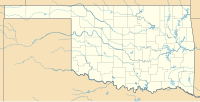
Photo from wikipedia
Abstract Not only direct fault ruptures but also later mass movement may result in complicated frontal deformation of the faults. Consequently, the deformation front or the contacts between the unconsolidated… Click to show full abstract
Abstract Not only direct fault ruptures but also later mass movement may result in complicated frontal deformation of the faults. Consequently, the deformation front or the contacts between the unconsolidated materials from the hanging wall and footwall of the thrust fault may indicate the toe of the mass movement instead of the actual fault zone. In this study, we used a combination of surface electrical resistivity imaging methods and borehole records in order to investigate the geometries of the structures in the frontal deformation zone of the Chihshang Fault at the Dapo elementary school. From the cores, we observed three different geological components at the Dapo site: the conductive Lichi melange of the hanging wall, the colluvial gravels and the underlying fluvial-gravel layer at the footwall. The resistivity images from two parallel survey lines reveal that the position where the fault trace was thought to be is actually the toe of the slumping body's surface ruptures consisting of materials from the Lichi melange. On the basis of the resistivity images, we also found that the actual fault plane is located on the southeastern side of the resistivity survey line near the hilltop. As a result, we conclude that mass movement induced by the inter-seismic creeping, not direct faulting, is the main factor affecting the frontal deformation zone of the Chihshang fault at the Dapo site.
Journal Title: Journal of Applied Geophysics
Year Published: 2018
Link to full text (if available)
Share on Social Media: Sign Up to like & get
recommendations!